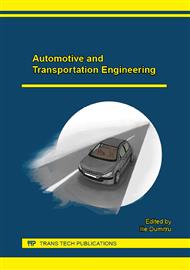p.299
p.305
p.311
p.321
p.331
p.341
p.346
p.354
p.360
Experimental Research on the Hybridization of a Road Vehicle
Abstract:
The electrification of the powertrain is one of the best solutions in the quest for obtaining emissions within the even more narrow limits imposed by legislation, with no penalty to the dynamic performances of the vehicle. This article describes a study regarding the possibilities of hybridization of a road vehicle. Based on real life situations, the custom driving cycles have been defined by means of GPS tracking. These driving patterns were further used in a simulation environment to test various configurations of classical and hybrid powertrains. The performances of the vehicle before and after hybridization were compared pursuing the change in emissions and fuel consumption.
Info:
Periodical:
Pages:
331-340
Citation:
Online since:
January 2016
Authors:
Keywords:
Price:
Сopyright:
© 2016 Trans Tech Publications Ltd. All Rights Reserved
Share:
Citation:


